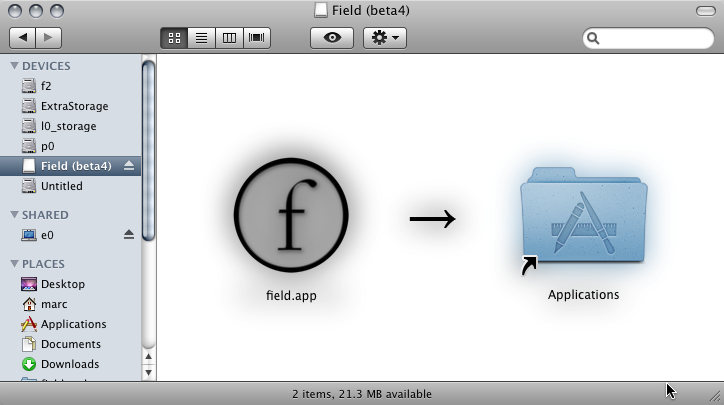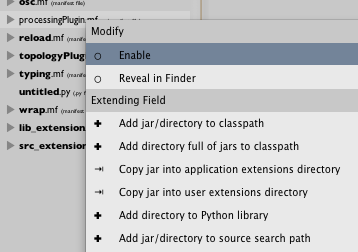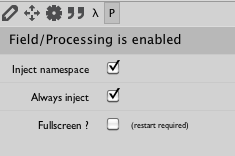
Field — Beta (Binary) Download
This is the page where you can download binary, beta, versions of Field for Mac OS X 10.6.
For a binary you will need:
- Snow Leopard (10.6).
- the latest Apple developer tools installed before you can install Field. Make sure they are recent.
- an Intel mac. We test and develop Field mainly on 64-bit capable "Core 2" Intel Macs or faster.
- Mercurial. For download and install this.
- For OS X, you might want to consider building from source.
- For Linux, there are no binary releases yet: build from source.
Over the next few months or so we are aiming to release a series of binary betas, culminating in something that we're all happy calling a version 1.0. Field has received quite a bit of testing in a small circle of users, but we're now looking for a more diverse set of eyes and voices.
Our nascent Google discussion group is field-development. Join it to be notified of updates to the binary releases, suggest improvements, join the development, sing praises, flame, tell us what you are using Field for etc.
To contact the core dev team directly Email field 'at' openendedgroup.com, but be warned, if it's a good question, the answer will be forwarded back to the field-development group (which you should probably join).
File bug reports at here.
Field is distributed under version 3 of the GPL license and it has dependancies on a number of other open source projects with diverse open source licenses — contributions that we gratefully acknowledge. Without them Field (and our work over the years in it) would not exist. Our source is here — share and enjoy it the same way.
For those of you wanting to help out on the bleeding edge, but not necessarily wanting to go to the trouble of building your own Field, current binaries are posted in the news section.
Finally, you can download the latest Alpha12 here.
Installing
After you've downloaded one of the Beta releases below you'll be greeted with a familiar sight:

Simply drag the Field application icon to the handy Applications directory shortcut to install Field.
Once you've done so, double-click on Field to start it up. If Field bounces and then disappears proceed to the "what can go wrong" section below.
Field will prompt you for a workspace directory. Field wants to put all of your files in one place — so that it can keep track of every version of them and offer you the chance to roll back and forward through this history. Field is asking for "this place". We suggest you just go to your Documents directory and select that. You'll get a new directory called "FieldWorkspace" automatically made there.
Now that you've done those two things (which you'll never have to do again, even when you upgrade Field), Field will run.
For Processing users
Field comes with special support for Processing users and Processing's libraries, but you'll have to turn this support on. This tutorial has all the instructions, but we'll repeat them here. Let's assume you have a very recent Processing installation in your Applications directory, and that there aren't any old versions of Processing hanging out near it.
- First you need to tell Field that you want to use the ProcessingPlugin. On the Tool Palette locate the Plugin Manager tab (the thing that looks like an on/off button on the far right). In this list find the processingPlugin and right click on it:

Restart Field like it suggests you do.
When Field starts up you'll have an additional window, this is the Processing "Applet" that Field is writing code for. Often, for the purposes of keeping example code as similar to that of Processing itself, you'll find a recommendation to turn this option on as well:

"Always inject applet into globals" means that you can just write, say, background(100) to change the background color of the canvas. We recommend doing so until you get the hang of Field.
What can go wrong
Sometimes we get reports from people that Field crashes on startup. First of all, let's make it clear: we want to hear from you. Field works, and works well, for a lot of people; we're well past the stage where Field crashing is acceptable.
Current known startup bugs and issues:
- Field generally does not start up properly on some MacBooks (with GMA X3100 based GPUs) — #169 — but we'd like to hear otherwise. We have spent so long trying to fix this that at this point we're likely to give up — after all, it seems that Apple have given up on this particular generation of Intel graphics.
- Field generally does not like to start up on Linux machines with ATI graphcs cards. Again, we suspect the drivers.
Warranty & License
This program is free software: you can redistribute it and/or modify it under the terms of the GNU General Public License as published by the Free Software Foundation, either version 3 of the License, or (at your option) any later version.
This program is distributed in the hope that it will be useful, but without any warranty; without even the implied warranty of merchantability or fitness for a particular purpose.
By downloading this software you are agreeing to use this software under the terms of the GPL 3 license.
Releases
Download Alpha12 — "The New Field"
New features 1. Complete redesign of both the windowing toolkit Field uses and it's OpenGL bindings. Field was a Swing/JOGL app, it's now primarily an SWT/LWJGL app. This was a quite ridiculous amount of work, but this it does three things to future-proof Field: firstly, we now have a Linux port of Field; Secondly, we are as independent of Apple's AWT implementation as you can be right now. Should Apple be unable or unwilling to ship a working AWT implementation within the 10.7 time-frame we'll at least have options (either SWT directly on OS X or moving away from OS X completely). Finally, by moving LWJGL we get to use a supported, upgradable set of bindings to OpenGL without becoming incompatible with Processing (which seems stuck on JOGL 1.x). 2. The Linux port. Tested on Ubuntu 10.10 with NVidia graphics drivers on both 32 and 64 bit JVMs. Users wanted. I can almost see a Windows Port from here. 3. Embedded web-server for in-browser Javascript development (see /OnlinePlugin) 4. Field can now be a Syphon client (see http://syphon.v002.info/) 5. Field has GStreamer support out of the box (see http://gstreamer.freedesktop.org/) 6. The foundations of a new contextual help system. 7. Better support for SVG importing. 8. New "Filesystem" component — drag and drop templates, boxes and properties from other documents directly onto the canvas. 9. Better support for Clojure. 10. A new option-drag gesture for starting multiple boxes quickly. 11. Support for both Active and Passive stereo rendering. Our Mac NVidia 3d vision drivers are currently not bundled with Field. Contact us if you want to test them. 12. On canvas Scene list support allows Field graphics system elements to be integrated directly onto the canvas. 13. Field graphics system supports saving image streams, and often requested feature. 14. On the order of 100 bug-fixes and tweaks.
Known issues 1. 32-bit mode is currently non-functional on OSX. There is a work-around, but it isn't as straightforward as the old "Get Info" palette in the Finder. Contact us if there's a 32-bit JNI library that you are dependent on. 2. The history and logging palettes have not been ported to this version of Field yet. 3. GUI elements embedded in text from old documents break when they are loaded into new documents. 4. New GUI Elements have the occasional rendering issue. 5. There's no welcome screen when you start Field up — it just sits there offering menu options. This confuses everybody at least once. 6. We've basically given up trying to make OpenGL work right on Intel GMA/GMX based machines — this includes some old Mac Minis and some old Mac Books. The integrated, battery saving graphics on the "early 2011" MacBook Pros have not been tested. 7. While this version of Field has been battle tested in Galleries and Museums, it isn't nearly as well tested as previous builds have been.
We expect, given all the new code that's gone into this release, that there will be a new build quite soon.
Thanks to all of the secret inner circle of Field testers, in particular: Nick Rothwell, Liubo Borissov, Jeffery Trevino, Hunter McCurry, Al Matthews, Dylan Enloe & Eric Ameres.
beta11 — Snow leopard only
Changes: More Presentation mode work allows you to change the appearance, behavior and arrangement of sheets — including "window space" boxes; Clojure 1.2 support; Experimental IOSurface base quicktime playback (works great on some machines, less great on others). QTKitVideo now has getPosition call. New Properties window and Color well inspired by Nodebox2; Readback support for FBOs in graphics system; Syntax color highlighting can now be changed in the editor. Upgrade to Jython trunk. MaxMSP data sharing. Platform independent Quaqua hybrid look and feel; upgrade to ASM 3.2 has made Java-based generators much more stable; Upgrade to JFBX SDK 2010; incorporation of libnvstusb-based driver for NVidia 3d vision glasses into source tree & tweaks to active stereo rendering mode; execution ruler now keeps and can show execution history; new dynamicQuad_long geometry type; can stop and start generators from execution ruler; Raw Mesh and streaming geometry classes; Pause / Resume available from marking menu for running boxes.
Share, enjoy and head off to the documentation.
beta10
Main features: New Processing integration (now you can mix Processing code and Python code in the same Field document); fewer memory leaks; Jitter support in Max Plugin; Presentation mode (à la Max); templating system; now works with multiple PApplet's (no silly warning on sheet reopen).
Minor / hidden tweaks / plumbing: better error messages (with hyperlinks to the offending box of code); graphics system now compiles and runs on recent Ubuntu and Windows; better transient time slider; minor Freehand 3d tweaks; withExtensions option is now case insensitive; Processing now saves things to sheet data directory rather than nowhere; typo's in line intersection code and visitPolar; super-fast multithreaded renderer option (not quite ready to be the default); multiline text in PLine; incremental upload classes for graphics system; Field tries hard to demand own local copies of JOGL; fixed indentation problems in telnet / Maya bridge; Added a first pass at a NodeBox2 integration.
beta9a
Huge update. Main Features: Max/Field plugin; OpenCL support in Snow Leopard; UnitTesting framework; the TypingPlugin, support for recording actions on the canvas and turning them back into elements, new ways of decorating visual elements, offsetFromSource PLines; new launch mechanism seems to work much better on Leopard and Snow leopard; transient time markers and better keyboard control of time. Copy & Paste where it should be.
And some smaller changes: PLine moveBy/lineBy, fixes to LineBasedInteraction, MarkingMenus; Apple= now cycles between elements; Added Clojure to list of available languages; Inherited properties shown in drop-down box; added Font size command line option / preference; added right hand side version of SimpleLinearAlgebra.
beta8b
A bit of an emergency beta this one — it looks like Apple's Java patch that was pushed out with Software Update is breaking some people's Field installations.
But there's still a lot of good stuff here. In addition to the small tweaks below we have the OscPlugin; better 3d PLine support; The Stats Box; the return of the history plugin; and the disappearance of some issues we were having with ATI x2600 graphics drivers.
Detailed change list: Can now edit spline handles for 3d splines; Better error handling in slider callbacks; Added @InProcessing to allow callbacks to run inside the Processing render method; Sped up history plugin considerably; Improved 3d camera control; Added getWindowedCanvas call; better error handling for GLSLang shaders; tighter use of System.out; Engineering level changes towards windows port; Stats Box; one argument delete call in VisualElement; added -editorFont option for fixed width font; smoothed keyboard controlled camera motion in canvases; added marker in ruler for running generator stack; fixed copy-paste problem from editors like aquamacs; jar file name collisions; OSC plugin; Added Ioke to list of slightly supported languages; upgrade to scala 2.8 pre-release; Shaders now understand Matrix4 uniforms; minor tweaks to FBX loader; 3d splines now export to PDF; added simple multi-line Python support in Maya; minor tweaks to SnapToGrid system; fixed issues with ATI 2600 cards.
Equivalent to changeset: 440 / tag "beta8".
beta7b
Changes: Most of these changes are either minor bugs in Processing Plugin or major feature additions & documentation driven changes to BaseGraphicsSystem. Under the hood we have some new Python integration tricks and the latest version of Jython.
Note: this version has disabled the History Plugin while we investigate a massive speed regression in loading the history information — history is still being tracked, but you just can't get to it through the Tool Palette. We'll get this feature back shortly.
Detailed change list: Core Image integration now works in full screen renderer; SnapToGrid; Element Browser no longer eats and keeps a CPU core every time it opens #171; Deep Python integration work; problems with workspace's with spaces in them; misc Cassiel Processing bugs; horrible sneaky issue with Globals introduced in last beta; Processing plugin will always try to balance popMatrix with pushMatrix; Better element browser parsing; 3d PLine system now usable; First pass at NURBs support; JFBX cleanup; Texturing work in BaseGraphicsSystem; QTKitPlayer in BaseGraphicsSystem; About box now has beta version number. Back on latest Jython. Equivalent to changeset: 440 / tag "beta7b for real this time".
beta6
Changes: New keyboard shortcuts inside Text editor (apple-pgup and pgdown start and stop the current element); FullScreenCanvas now has Processing Plugin style event handlers; can now set hints for Processing Plugin from the command line; Fullscreen Processing now moves correctly to the front on run; Preview (f2) mode removes default boxes as well; FullScreenCanvas can take PLines; Text Transform blocks are no longer sensitive to extra spaces; The colorpicker now live-updates; added withExtensions and withoutExtensions; Long running tasks now show a wait symbol; added self.dataFolder and friends; added StartupOptions to sheet root; repaired startup race condition that caused a crash; upgraded to Jython2.5b4; fixed pasteboard issues; changed stdout/stderr redirection logic to be more reluctant to put the results of 'print' to the Console; fixed Processing resizing issues (for the 3rd time); fixed Processing non-core classpath issues; fixed QTJava / Processing problems; repaired embedded JavaC; Fixes for #158, #157_. Equivalent to changeset: 401 / tag "beta6".
'''beta5
Note: reposted at 9pm, 26/2/09. Changes: 'Internal changes to Jython bridge classes; cleaning up of repository; Another stab at a fix for our Python installer woes (see #142). Better support for embedded JavaC. Cursor.tangent() produces a direction vector not a position vector.'
''beta4
Changes: Many issues relating to Text Transforms (their rendering, their keyboard shortcut execution, their automatic string interpolation, the missing DictXML class that the docs talk about); hidden windows occasionally come back; misc fixes for "choreographic language agent" project. Equivalent to changeset: 362 / tag "beta4"
beta3
Changes: Possible (probable?) fix to bug #142, fatally bad mercurial install behavior on machines with different Python configurations; tweak to rawPython text transform; tweak to WrapInTransform ui. Equivalent to changeset 359 / tag "beta3"
beta2
Changes: Can now zoom the canvas without a 3 button mouse; option to hide / show all palettes; Processing no longer exits Field on escape; added getFullscreenCanvas to BaseGraphicsSystem; added hideCursor() to Processing Applet; rawPython now does /usr/bin/env python; hidden windows are now actually hidden rather than moved outside Marc's narrow cone of vision.
Equivalent to changeset 353 / tag "beta2".
beta1
Changes: Quick fixes for Processing Plugin in Fullscreen mode; added keyboard shortcut support to arbitrary boxes; keyboard events now get passed from Processing window to the canvas; Faceless support revised to include Processing Plugin; fixed packaging problems with BaseGraphicsSystem; added rawpython transform to TextTransforms. Equivalent to changeset 345 / tag "beta1".
beta0
The first beta binary release. Equivalent to changeset 339 / tag "beta0".